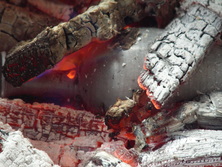|
Earth and fire
The mysteries that come out of simply mixing those two elements are a never-ending journey that is fascinating and holds in it infinite surprises. Old/primitive firings have a special meaning to me and never-ending challenge. That's why I do it... The process itself is the mentor and the results are the teachers. The more you do it- the more you find new horizons to search. |
Pit Firing
Pit firing is the oldest known method of pottery firing. Examples have been dated as early as 29,000–25,000 BC.
Unfired pots are nestled together in a pit in the ground and are then covered with combustible materials such as wood shavings, leaves, sawdust, salts and metal oxides. The filled pit is then set on fire and carefully tended until most of the inner fuel has been consumed. The temperature reached is 800-1,000 Celsius. After cooling, pots are removed and cleaned to reveal patterns and colors left by ash and salt deposits. Since the pots are not glazed, they don't hold water.
Unfired pots are nestled together in a pit in the ground and are then covered with combustible materials such as wood shavings, leaves, sawdust, salts and metal oxides. The filled pit is then set on fire and carefully tended until most of the inner fuel has been consumed. The temperature reached is 800-1,000 Celsius. After cooling, pots are removed and cleaned to reveal patterns and colors left by ash and salt deposits. Since the pots are not glazed, they don't hold water.
Pit firing in action!
Raku
Raku ware is a type of Japanese pottery that originates traditionally from the Japanese tea ceremony, most often in the form of tea bowls. "Raku" means "enjoyment", "harmony" or "ease". It is characterized by being hand shaped rather than thrown, fairly porous vessels, which result from low firing temperatures and the removal of pieces from the kiln while still glowing hot. In the traditional Japanese process, the fired raku piece is removed from the hot kiln and is allowed to cool in the open air or in a container filled with combustible material. It is used once, and thrown away after it. Raku techniques have been modified by contemporary potters worldwide.
Western potters are using the same technique today and creating different styles of vessels. Because the pots are removed from the hot kiln directly - crackles are formed (due to the thermic shock they undergo).
Western potters are using the same technique today and creating different styles of vessels. Because the pots are removed from the hot kiln directly - crackles are formed (due to the thermic shock they undergo).
